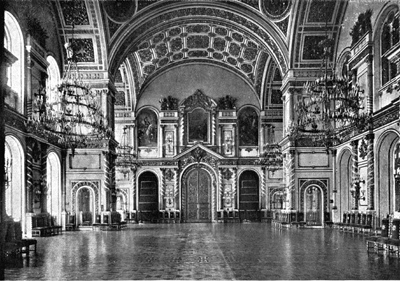Olson Defendorf Custom Homes wins prestigious design award from Houzz.
Written, under the order of Prince Odoievsky-Maslov, Chief of Administration of the Imperial Court in Moscow, by S. de Bartenev
St Alexander Hall

The walls are of stucco imitating pink marble, glittering with gold. The Order of St. Alexander Nevsky, in whose honor the hall was built, was founded in 1725 by Catherine I, realising a wish of Peter the Great. The motto of the Order is "For the Work and the Nation"
The spherical coupola of the ceiling rests on arches supported by four pillars.
The bas-reliefs in gold on the coupola and those on the arches carry the insignia of the Order, with the initials S.A. (Sanctus Alexander). In the corner pieces, as well as above the doors are the Imperial Arms, the double-headed eagle with the Imperial Crown.
Between the gilded bust columns are the arms of the governments of Russia and the annexed provinces.
On the entablature above the columns, between the doors and the windows, are gilded trophies, composed of the ancient arms of the Slavs.
On the walls are paintings by Professor Moller, depicting the following facts of the life of St. Alexander Nevsky:
1. The ambassadors of Pope Innocent IV and Cardinals Gald and Gemont persuading Alexander Nevsky to embrace Catholocism. They assured him that his father Yaroslav had made the promise to the Catholic monk Plano Carpini (a celebrated traveller) when they had encountered the Horde. "We know the true doctrine of the Church," replied Alexander Nevsky, "we do not accept yours and do not wish to know it."
2. Marriage of Alexander Nevsky to Alexandra, daughter of the Prince of Polotsk.
3. Alexander Nevsky refuses to worship the fire and the bush, according to the Tatar ritual. "Go tell Batyii," he said to the head of the Tatar troops, "that I render hommage to him as a sovereign, as he is such by the grace of God, but I will not prostrate myself before and object which was made only for the use of man. I acclaim only the one God who I serve and adore.
4. Triumphal entry of Alexander Nevsky into the city of Pskov, which he saved from the invasion of the Livonian horsemen in 1242.
5. Pelgui of Ijor explains to Alexander the vision which he had of St. Boris and St. Gleb, as a premonition of his victory over the Germans - Lyedovoyie poboystchye - the battle on ice of 1242.
6. Victory over the Swedes; Alexander kills Birger with a blow of his lance to the face in 1240.
The paintings above the door represent Alexander Nevsky as prince and ascetic monk, these paintings are suspended from two gilt figures, emblems of glory, and the work of professor Loganovsky.
During the Emperor's stay in this Palace, the four sideboards from the two sides are covered above and below with ancient vessels in silver and gold, usually kept ordinarily in the Armory Palace.
The four fireplaces are in marble and adorned with elegant little columns, entwined with foliage made of bronze. The candelabras were made by Barbedienne in Paris.
The gilded armchairs, made in Tours, are covered in velvet in the color of the ribbon of the Order and on the back of each is embroidered the Order's star.
The parquet floor is a rare beauty, the work of Blechschmidt, and is made up of precious woods, just as in the St. George's Hall.
The Hall is lit by day from the two rows of windows and at night by six chandeliers and twenty eight sconces, which all have approximately 3500 electric lights. The wall opposite is decorated by doors and false windows glazed with mirrors.
In the St. Alexander's Hall, the ladies of the city will gather on the great solemn occassions.
The St. Alexander's Hall occupies the former site where the Ambassador's Hall was located in the 17th century, as well as the vestibule where the Boyars and foreign Ambassadors deliberated. In that room there was a hidden chamber (Tainik) where the Tsar, unseen, could follow the deliberations.

